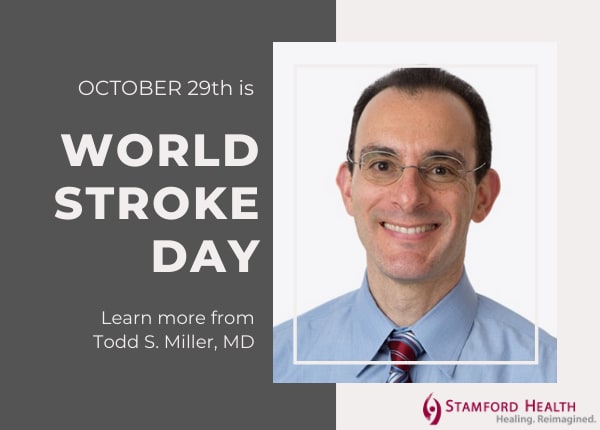Stroke is the fifth leading cause of death in the U.S. and the leading cause of disability around the world. In recent years efforts to control blood pressure, dyslipidemia and diabetes, and address atrial fibrillation (a common heart rhythm abnormality that causes stroke), have resulted in decreased stroke frequency in patients over 65.
While the incidence of stroke is decreasing overall in this country, rates among young adults are increasing. Roughly 800,000 Americans suffer strokes each year. While only 15% of strokes occur in those aged 18-50, 120,000 Americans under 50 and 1.5 million young adults worldwide suffer strokes each year. The incidence of stroke in people ages 20-44 has risen from 17 per 100,000 in 1993 to 28 per 100,000 in 2015. The risk to patients in the prime of their lives is considerable.
Stroke symptoms in young adults are similar to those seen in older adults:
- Sudden onset of weakness, or numbness in the face, arm, or leg.
- Sudden change in speech.
- Sudden difficulty walking or maintaining balance.
- Sudden severe headache.
- Sudden change in vision.
There are two types of stroke:
1. Ischemic stroke, in which the flow of blood and oxygen is disrupted causing damage to brain tissue. (In older adults, hypertension, cardiac disease, and atherosclerosis of major vessels are major causes.) This represents roughly 85% of strokes in the overall stroke population and 60% of strokes seen in patients under 50.
2. Hemorrhagic stroke, in which blood leaks out of a vessel into or around the brain causing disruption to underlying brain tissue (caused by hypertension, malformations of cerebral blood vessels) comprises about 15% of all strokes, but 40% of strokes in patients under 50.
Strokes in young adults
There some causes of stroke commonly seen in younger adults not seen as often in those over 65 including:
Cervical artery dissection: accounts for 10-25% of strokes in young adults but only 2% of strokes in patients over 65. Damage to the wall of large vessels in the neck causes disruption of blood flow. This can occur spontaneously or when there is intense physical stress on the neck as might be seen with vigorous coughing, vomiting, or with weightlifting. Dissections can also be seen in patients with underlying genetic diseases causing abnormalities of blood vessels. Dissections are often associated with neck pain, headache, and a drooping eyelid before the onset of stroke symptoms.
Patent foramen ovale: a communication between the right and left side of the heart can enable clots from the leg to pass into blood vessels heading to the brain. About 24-40% of the population have PFOs so the existence of a PFO does not mean the stroke was caused by it. Still it remains an important cause of stroke in patients under 50.
The importance of PFO-associated stroke was highlighted by the model/actress Hailey Bieber who described her stroke symptoms and the procedure she underwent to close the PFO.
Underlying blood clotting abnormalities: can cause both ischemic and hemorrhagic stroke.
Drug use: individuals using cocaine within 24 hours had a six-fold increase in the risk of stroke with the risk highest when smoking was the method of use.
Genetic diseases: such as Fabry disease or Moyamoya disease can be associated with stroke.
How is stroke diagnosed and what do people need to know?
Thanks to modern imaging techniques, especially MRI, doctors can make the diagnosis of stroke more reliably and rapidly. CT and MR imaging can identify the site of blood vessel blockages and accurately direct treatment.
Recognize that strokes occur, and with increasing frequency, in young adults. Age does not protect someone from suffering the devastating effects of stroke. Unfortunately, young patients with stroke often arrive at the emergency room later than older patients. When young adults suddenly develop neurologic symptoms, they should be seen in the ER immediately. They may benefit from the clot-busting therapies like TPA, an intravenous medication that can help dissolve clots, or thrombectomy, mechanical removal of a clot from a blood vessel.
Though there are stroke causes relatively unique to young adults, the recent increase in stroke frequency appears to be driven by an increase in traditional cardiovascular risk factors in younger adults. Hypertension, obesity, dyslipidemia, and Type 2 diabetes are all seen with increasing frequency in young adults. These factors along with cigarette smoking and sedentary lifestyles are causing young adults to suffer the kind of ischemic strokes traditionally seen in patients over 65. About 50% of young adults with strokes have high blood pressure, 14% of young adults with stroke have diabetes and 22% of young stroke patients are obese.
Fortunately, these are modifiable risk factors! Early detection of these problems and aggressive treatment is of the utmost importance. High blood pressure often goes undetected and causes stroke, heart disease, and kidney disease. Blood pressure assessment even in young adults is a must. Exercise and healthy eating can help decrease the risk of stroke as well. Control of the risk factors such as hypertension, hyperlipidemia, obesity, diabetes, and alcohol abuse could prevent 3/4 of strokes worldwide.
About the Author
Louise D. Resor, MD, is a neurologist and the former director of neurology at Stamford Health.
Featured Expert/ Author









